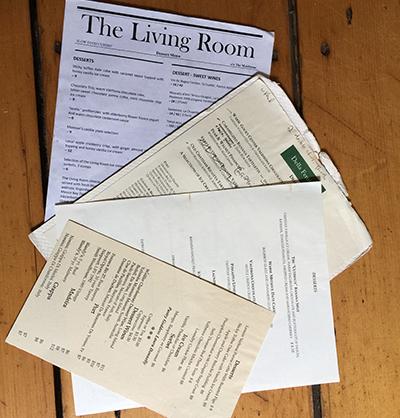Seasons by the Sea: So Good, They Have a Monster

Everyone loves cookies. Cookies are so good they have their own monster. No other food has a monster, does it? Does lasagna have a monster? Cheetos? No, only cookies.
Cookie Monster, who came out of the brilliant mind of Jim Henson in 1966, started life in commercials for snack foods and IBM. By the time “Sesame Street” first aired in 1969, he had become a blue, furry, clumsy creature whose grammar was atrocious and appetite for cookies insatiable. The cookies for the show were made of rice cakes, which were painted and dotted with a glue gun to look like that ultimate cookie, the chocolate chip. Real cookies would have messed up the puppet costume.
The word “cookie” most likely comes from the Dutch word “koekje,” which means “small or little cake.” They are called biscuits in England and Australia, galletas in Spain, and kok in Germany. According to the website What’s Cooking America, the first cookies may have been test cakes, drops of batter used to test an oven’s temperature for baking. But cookies have really been around since seventh-century Persia, one of the first countries to cultivate and process sugar and put it into cakes and pastries.
One of the earliest cookbooks with a recipe for cookies was the 1596 “Goode Huswife’s Jewel” by Thomas Dawson. “Take fine flowre and good Damaske water you must have no other liquer but that, then take sweet butter, two or three yolkes of eggs, and a good quantity of sugar, and a few cloves and mace, as your Cookes mouth shall serve him, and a lyttle saffron, and a little God’s good about a spoonful if you put in too much they shall arise,” and the recipe continues in this stream of consciousness manner for a whole paragraph.
Desserts and cookies did not earn a chapter in cookbooks for a while. They were listed in the back of cookery books as Jumbles, Plunkets, and Cry Babies.
Some historians believe fortune cookies came about during the 12th and 13th centuries when Chinese soldiers would sneak rice paper messages into mooncakes to help coordinate battles against Mongolian invaders. Apparently they knew the Mongolians didn’t like the lotus nut paste traditionally put into the cakes. Chu Yuan Chang, a political revolutionary, disguised himself as a Taoist priest, entered occupied walled cities armed with mooncakes that had instructions for coordinating the uprising, and thus began the Ming Dynasty.
Cookies have also been described by the great baker Maida Heatter as a form of diplomacy. Indeed, I have used the gift of a platter of cookies many times to sway, seduce, bribe, thank, comfort — you name it; cookies can do it. I have gotten into yard sales early by taking cookies, and my son’s grades may have improved a fraction by a gift of cookies at a parent-teacher conference.
One of my favorite ways of sharing cookies has been in the restaurant business. As a pastry chef, I would always have the kitchen to myself in the early morning hours. The only company was a radio and the constant flow of delivery men and women from Dairyland, Baldor, Gosman’s, Cromer’s, Satur Farms, Braun Seafood, Balsam Farms, wine distributors, and many more. Being able to offer a cookie or two and a cup of coffee to these guys who had been battling traffic all alone was a treat for me. Sometimes the favor would be returned in the form of a little fillet of Spanish mackerel from Fuzzy, a family recipe for grilled shrimp from Gosman’s, some extra arugula from Patty of Early Girl Farm.
At one restaurant I worked for in East Hampton, the owner was not too terribly up to date on paying his bills. A large, very large, ponytailed gentleman would show up frequently in a chauffeur-driven Cadillac and come through the back door looking for his money. He was scary but polite to me, and I plied him with more biscotti and espressos than was probably necessary. He knew I didn’t have anything to do with the payroll, but he was still sending a Sopranos-style message through me to the owner.
I also loved having enough cookies on hand for the staff. This would drive some of my colleagues batty (Alexandra!) but to me it was important for them to be able to just grab a little treat during a long, brutal shift of busing, waiting tables, washing dishes, and cooking.
Is baking cookies a lost art? I hope not, because cookies are one of the fastest and cheapest things you can whip up for a snack or dessert. Make enough dough, roll it into logs, and freeze it. Now you’ve got cookies anytime you want. They can be healthy oatmeal with dried fruit and nuts, or gooey, rich, decadent chocoholic delights.
You can tailor your cookie selections to match menus and seasons. In winter, after a hearty soup or stew, it’s nice to have ginger molasses cookies or hermits. In summer, after some grilled fish and salad, lemony cookies with a sorbet are perfect. Soon we will have local strawberries, followed by peaches, plums, blueberries, and raspberries. A bowl of berries with a simple, crisp cookie is a homemade dessert, just not a lot of work.
If you’re interested in composing a cookie platter, think about texture, color, and taste. You should always have America’s favorite — chocolate chip — along with oatmeal, perhaps pecan sandies, and the aforementioned lemon cookie. Biscotti last forever, they’re easy as pie to make, and they’re good for dunking into coffee.
For an Italian-themed meal you could make marzipan pine nut cookies and amaretti. For a Moroccan feast, make some cardamom-scented almond cookies and apricot-jam-filled sugar cookies. French: tuiles and cat’s tongues. American barbecue: brownies and snickerdoodles. You get the idea, now get baking!
Click for recipes
